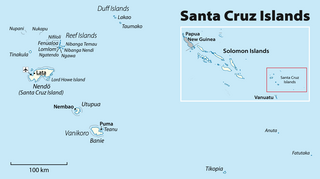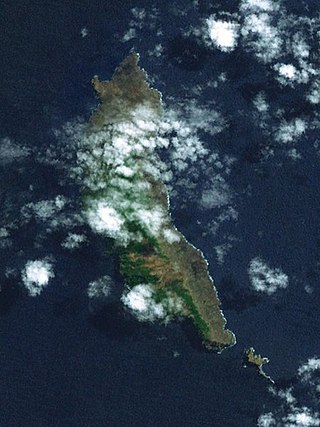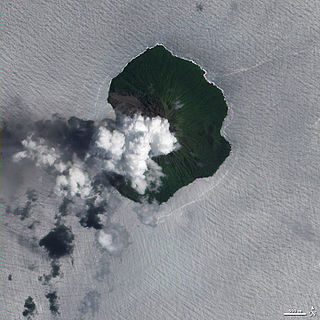
1595 (MDXCV) was a common year starting on Sunday of the Gregorian calendar and a common year starting on Wednesday of the Julian calendar, the 1595th year of the Common Era (CE) and Anno Domini (AD) designations, the 595th year of the 2nd millennium, the 95th year of the 16th century, and the 6th year of the 1590s decade. As of the start of 1595, the Gregorian calendar was 10 days ahead of the Julian calendar, which remained in localized use until 1923.

The Marquesas Islands are a group of volcanic islands in French Polynesia, an overseas collectivity of France in the southern Pacific Ocean. Their highest point is the peak of Mount Oave on Ua Pou island, at 1,230 m (4,035 ft) above sea level.

Pedro Fernandes de Queirós (1563–1614) was a Portuguese navigator in the service of Spain. He is best known for leading several Spanish voyages of discovery in the Pacific Ocean, in particular the 1595–1596 voyage of Álvaro de Mendaña y Neira, and for the 1605–1606 expedition that crossed the Pacific in search of Terra Australis.

The Santa Cruz Islands form an archipelago in Temotu Province, Solomon Islands. They lie approximately 250 miles to the southeast of the Solomon Islands archipelago, just north of the archipelago of Vanuatu and are considered part of the Vanuatu rain forests ecoregion. The term Santa Cruz Islands is sometimes used to encompass all the islands of Temotu Province, Solomon Islands.

Pedro Sarmiento de Gamboa (1532–1592) was a Spanish adventurer, author, historian, mathematician, and astronomer. His birthplace is not certain and may have been Pontevedra, in Galicia, where his paternal family originated, or Alcalá de Henares in Castile, where he later is known to have studied. His father Bartolomé Sarmiento was born in Pontevedra and his mother María Gamboa was born in Bilbao, Basque Country.

Mohotani is an uninhabited island southeast of Hiva Oa and east of Tahuata in the southern Marquesas Islands. It has an area of 15 km2. Much of the island's sparse vegetation has been destroyed by feral goats and sheep, to the extent that following its rare rains, the sea around it is stained red from runoff. Early reports describes the island as fertile, with forest and fields. When Thor Heyerdahl visited the island in 1938, there were only a few goats and remains of deserted huts and villages.

Álvaro de Mendaña y Neira was a Spanish navigator, explorer, and cartographer, best known for two of the earliest recorded expeditions across the Pacific Ocean in 1567 and 1595. His voyages led to the discovery of the Marquesas, Cook Islands, and Solomons among other archipelagos. Born in Congosto, in El Bierzo Region (León), he was the nephew of Lope García de Castro, viceroy of Peru.
Adelantado was a title held by some Spanish nobles in service of their respective kings during the Middle Ages. It was later used as a military title held by some Spanish conquistadores of the 15th, 16th and 17th centuries.

Tinakula is a conical stratovolcano which forms an island north of Nendo in Temotu Province, Solomon Islands. It lies at the north end of the Santa Cruz Islands. It is about 3.5 kilometres wide and rises 851 metres above sea level, rising three to four kilometres from the sea floor. The volcano was first recorded in eruption in 1595 when Spanish explorer Álvaro de Mendaña sailed past it during his second expedition across the Pacific Ocean.

Roncador Reef is a reef in Solomon Islands, south of Ontong Java Atoll and north of Santa Isabel Island.
San Jorge Island is the second largest island in the Isabel Province, Solomon Islands.

Utupua is an island in the Santa Cruz Islands, located 66 km to the Southeast of the main Santa Cruz group, between Vanikoro and Santa Cruz proper (Nendö). This island belongs administratively to the Temotu Province of Solomon Islands.
This article details the history of the Marquesas. The Marquesas Islands are a group of volcanic islands in French Polynesia, an overseas collectivity of France in the southern Pacific Ocean. The Marquesas Islands comprise one of the five administrative divisions of French Polynesia.

Vanikoro is an island in the Santa Cruz group, located 118 kilometres to the Southeast of the main Santa Cruz group. It is part of the Temotu Province of Solomon Islands.
Ramos Island is an island in Solomon Islands; it is located in Isabel Province.
Luís Vaz de Torres, or Luis Váez de Torres in the Spanish spelling, was a 16th- and 17th-century maritime explorer of a Spanish expedition noted for the first recorded European navigation of the strait that separates the Australian mainland from the island of New Guinea, and which now bears his name.

Nendö is the largest of the Santa Cruz Islands, located in the Temotu province of Solomon Islands. The island is also known as Santa Cruz, Nendo, Ndeni, Nitendi or Ndende. The name Santa Cruz was given to the island in 1595 by the Spanish navigator Álvaro de Mendaña, who started a colony there. Historically, the island has also been called New Guernsey and Lord Egmont's Island, after John Perceval, 2nd Earl of Egmont, First Lord of the Admiralty.
Early Polynesian explorers reached nearly all Pacific islands by 1200 CE, followed by Asian navigation in Southeast Asia and the West Pacific. During the Middle Ages, Muslim traders linked the Middle East and East Africa to the Asian Pacific coasts, reaching southern China and much of the Malay Archipelago. Direct European contact with the Pacific began in 1512, with the Portuguese encountering its western edges, soon followed by the Spanish arriving from the American coast.

Solomon Islands–Spain relations are the bilateral and diplomatic relations between these two countries. Solomon Islands does not have an embassy resident in Spain but maintains an honorary consulate in Madrid. Spain has an honorary consulate in Solomon Islands.











